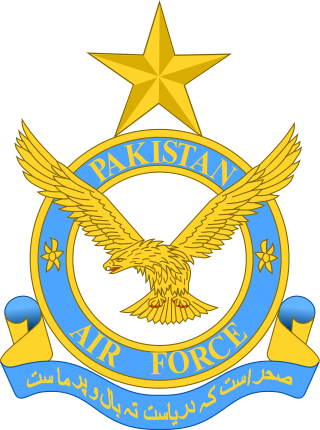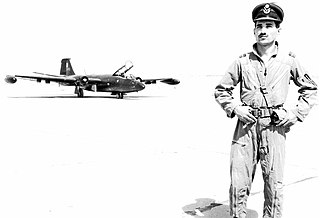
The Pakistan Air Force (PAF) is the aerial warfare branch of the Pakistan Armed Forces, tasked primarily with the aerial defence of Pakistan, with a secondary role of providing air support to the Pakistan Army and Pakistan Navy when required, and a tertiary role of providing strategic airlift capability to Pakistan. As of 2024, as per the International Institute for Strategic Studies, the PAF has more than 35,000 active-duty personnel. PAF stands as the eight largest Air Force in the world. PAF is the largest Air Force of the Muslim world in terms of aircraft fleet. Its primary mandate and mission is "to provide, in synergy with other inter-services, the most efficient, assured and cost effective aerial defence of Pakistan." Since its establishment in 1947, the PAF has been involved in various combat operations, providing aerial support to the operations and relief efforts of the Pakistani military. Under Article 243, the Constitution of Pakistan appoints the President of Pakistan as the civilian Commander-in-Chief of the Pakistan Armed Forces. The Chief of the Air Staff (CAS), by statute a four-star air officer, is appointed by the President with the consultation and confirmation needed from the Prime Minister of Pakistan.

The Pakistan Navy (PN) is the naval warfare branch of the Pakistan Armed Forces. The Chief of the Naval Staff a four-star admiral, commands the navy and is a member of the Joint Chiefs of Staff Committee. The Pakistan Navy operates on the coastline of Pakistan in the Arabian Sea and Gulf of Oman. It was established in August 1947, following the independence of Pakistan from the United Kingdom.

Operation Trident was an offensive operation launched by the Indian Navy on Pakistan's port city of Karachi during the Indo-Pakistani War of 1971. Operation Trident saw the first use of anti-ship missiles in combat in the region. The operation was conducted on the night of 4–5 December and inflicted heavy damage on Pakistani vessels and facilities. While India suffered no losses, Pakistan lost a minesweeper, a destroyer, a cargo vessel carrying ammunition, and fuel storage tanks in Karachi. Another destroyer was also badly damaged and eventually scrapped. India celebrates its Navy Day annually on 4 December to mark this operation. Trident was followed up by Operation Python three days later.
Operation Dwarka, codenamed as Operation Somnath, was a naval operation by the Pakistan Navy to attack the Indian coastal town of Dwarka on 7 and 8 September 1965. This instance was the first engagement by the Pakistan Navy in any of the Indo-Pakistan Wars.
Operation Python, a follow-up to Operation Trident, was the code name of a naval attack launched on West Pakistan's port city of Karachi by the Indian Navy during the Indo-Pakistani War of 1971. After the first attack during Operation Trident on the Port of Karachi, Pakistan stepped up aerial surveillance of its coast as the presence of large Indian Navy ships gave the impression that another attack was being planned. Pakistani warships attempted to outsmart the Indian Navy by mingling with merchant shipping. To counter these moves, Operation Python was launched on the night of 8/9 December 1971. A strike group consisting of one missile boat and two frigates attacked the group of ships off the coast of Karachi. While India suffered no losses, Pakistani fleet tanker PNS Dacca was damaged beyond repair, and the Kemari Oil Storage facility was lost. Two other foreign ships stationed in Karachi were also sunk during the attack.

Naval tactics and doctrine is the collective name for methods of engaging and defeating an enemy ship or fleet in battle at sea during naval warfare, the naval equivalent of military tactics on land.
Okha port is a census town in Devbhumi Dwarka in the Indian state of Gujarat.
East Pakistan Air Operations covers the activity of the Pakistan Air Force (PAF) and Pakistan Army Aviation units in former East Pakistan during the Bangladesh Liberation War. The operations involved the interdiction, air defense, ground support, and logistics missions flown by the Bangladesh Air Force, Indian Air Force, and the Indian Navy Aviation wing in support of the Mukti Bahini and later Indian Army in Bengal.

Najeeb Ahmad Khan, commonly known as 8-Pass Charlie, was a Pakistani bomber pilot who raided the Adampur Airbase in India a number of times during the Indo-Pakistani War of 1965, notably starting a series of airstrikes on the base by a solo raid.
Sitara-e-Jurat is the third highest military award of Pakistan. It was established in 1957 after Pakistan became a republic; however, it was instituted retrospectively back to 1947. It is awarded for gallantry or distinguished service in combat; and can be bestowed upon officers, junior commissioned officers, petty officers, warrant officers, soldiers, sailors, airmen, and equivalents in the Pakistan Army, Navy, Air Force, and various paramilitary forces under federal control, such as the Frontier Corps, the Frontier Constabulary, and the Pakistan Rangers. It may be considered to be roughly equivalent to the Military Cross and the Silver Star.

During the Indo-Pakistani war of 1965, the Indian and Pakistani Air Forces engaged in large-scale aerial combat for the first time. In the air war, which took place in September, both air forces conducted thousands of defensive and offensive sorties over Indian and Pakistani airspace. Both India and Pakistan claimed victory in the air war; Pakistan claimed to have destroyed 104 Indian aircraft and lost 19, and India claimed to have destroyed 73 Pakistani aircraft and lost 35 of its own. The air war ended in a stalemate.
The Vidyut-class missile boats of the Indian Navy were an Indian variant of the Soviet Osa I class.
INS Vinash (K85) (Destruction) was a Vidyut-class missile boat of the 25th Killer Missile Boat Squadron of the Indian Navy.
The Indo-Pakistani Naval War of 1971 refers to the maritime military engagements between the Indian Navy and the Pakistan Navy during the Indo-Pakistani War of 1971. The series of naval operations began with the Indian Navy's exertion of pressure on Pakistan from the Indian Ocean, while the Indian Army and Indian Air Force moved in to choke Pakistani forces operating in East Pakistan on land. Indian naval operations comprised naval interdiction, air defence, ground support, and logistics missions.

No. 9 Squadron, named the Griffins, is a Pakistan Air Force fighter squadron assigned to the No. 38 Multi-Role Wing of the PAF Central Air Command. The squadron is stationed at PAF Base Mushaf, Sargodha. It was the PAF's first fighter squadron and has been commanded by seven Chiefs of Air Staff of the Pakistan Air Force. The squadron crest is a red griffin which symbolises strength, aggressiveness, and vigilance. Scrolls around the squadron crest display the battle honours Sargodha 65 and Karachi 71.The Griffins are considered as the PAF's most elite unit as well as its most senior.

The No. 24 Electronic Warfare Squadron, nicknamed the Blinders, is an electronic warfare unit of the Pakistan Air Force equipped with DA 20EW Faclons. It is the PAF's only Electronic Warfare squadron and undertakes EW, ECM and ESM missions while also training Pilots, Air Defense controllers and engineering officers in EW environments.
PNS Muhafiz was an Adjutant-class minesweeper of the Pakistan Navy. It was built by the United States for transfer to Pakistan. PNS Muhafiz was sunk by a missile from INS Veer of the Indian Navy during the Indo-Pakistani War of 1971.

PNS Zulfiqar was a River-class frigate of the Pakistan Navy, originally built for the Royal Navy during the Second World War as HMS Deveron. Zulfiqar was damaged beyond repair by friendly fire from aircraft of the Pakistan Air Force (PAF) which mistook her for a missile boat of the Indian Navy during the Indo-Pakistani War of 1971.

No. 8 Squadron, nicknamed the Haiders, is a tactical attack squadron from the No. 32 TA Wing of the Pakistan Air Force's Southern Air Command. It is currently deployed at Masroor Airbase and operates the JF-17A Multi-role fighter.

The No. 14 Squadron, nicknamed Tail Choppers, is an air superiority squadron of the Pakistan Air Force's Central Air Command. It is one of PAF's most decorated squadrons which earned its nickname after a daring strike mission on the Kalaikunda Air Force Station during the 1965 War. Currently, the Squadron is deployed at PAF Base Rafiqui and operates the PAC JF-17 Thunder multirole aircraft.










